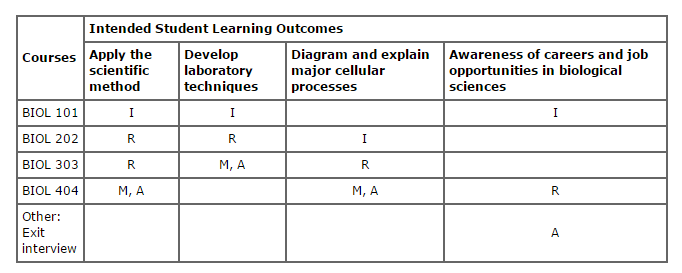After the student learning objectives are defined, the next step is to make sure students have an opportunity to learn and meet the objectives.
The purpose of a curriculum alignment matrix
After the student learning objectives are developed for the program, the next step in program assessment is to develop the curriculum alignment matrix. This matrix lists the learning objectives against the courses in the program and it becomes clear where assessment of student learning should occur.
The curriculum alignment matrix becomes the basis of the assessment plan. With this, faculty and/or assessment coordinator can determine what student artifact or work sample (signature assignment or other assignment(s)) can be used to measure progress towards the learning objectives and/or when the assessment will take place. In addition, the matrix will help point out any gaps in the curriculum.
As you build and review your curriculum alignment matrix, ask the following questions:
- Are there learning outcomes that are not associated with any course?
- Do we have appropriate levels of the desired performance associated with each SLO with respect to 1) introducing the learning outcome, and 2) practicing the learning outcome before mastery is expected?
- Do we have a place where we can measure mastery within the context of the program for each SLO?
- If answers to the above are "no," what changes do we need in our curriculum to achieve the desired results?
The exercise of building and reviewing a curriculum alignment matrix encourages reflection on the curriculum as a whole and can lead to better integration among courses.
Very simply, it's a table with one row for each learning outcome and one column for each course or required event/experience. Faculty identify where key learning outcomes are introduced (I), reinforced with the opportunity to practice (R or P), and where mastery (M) is achieved at the senior or exit level. When the matrix is complete, the program can identify where assessment evidence (A) should be gathered. In addition to courses, faculty should include any other required events/experiences (e.g., internships, department symposium, national licensure exams).
Here's an example of a curriculum matrix from a hypothetical Biology program*:

Key: "I"=Introduced; "R"=reinforced and opportunity to practice; "M"=mastery at the senior or exit level; "A"=assessment evidence collected
*Example from University of Hawaii, Manoa Assessment website.
- Within the curriculum, build in practice and multiple learning trials for students: introduce, reinforce, master. Students will perform best if they are introduced to the learning outcome early in the curriculum and then given sufficient practice and reinforcement before evaluation of their level of mastery takes place.
- Use the curriculum map to identify the learning opportunities (e.g., assignments, activities) that produce the program's outcomes.
- Ask if the department/program is trying to do too much. Eliminate outcomes that are not highly-valued and then focus on highly-valued outcomes by including them in multiple courses. (The eliminated outcomes can still be course-level outcomes. They need not disappear completely from the curriculum.)
- Set priorities as a department/program. Everyone working together toward common outcomes can increase the likelihood that students will meet or exceed expectations.
- Communicate: Publish the curriculum map and distribute to students and faculty.
- Communicate: Each faculty member can make explicit connections across courses for the students. For example, at the beginning of the course or unit, a faculty member can remind students what they were introduced to in another course and explain how the current course will have them practice or expand their knowledge. Do not expect students to be able to make those connections by themselves.